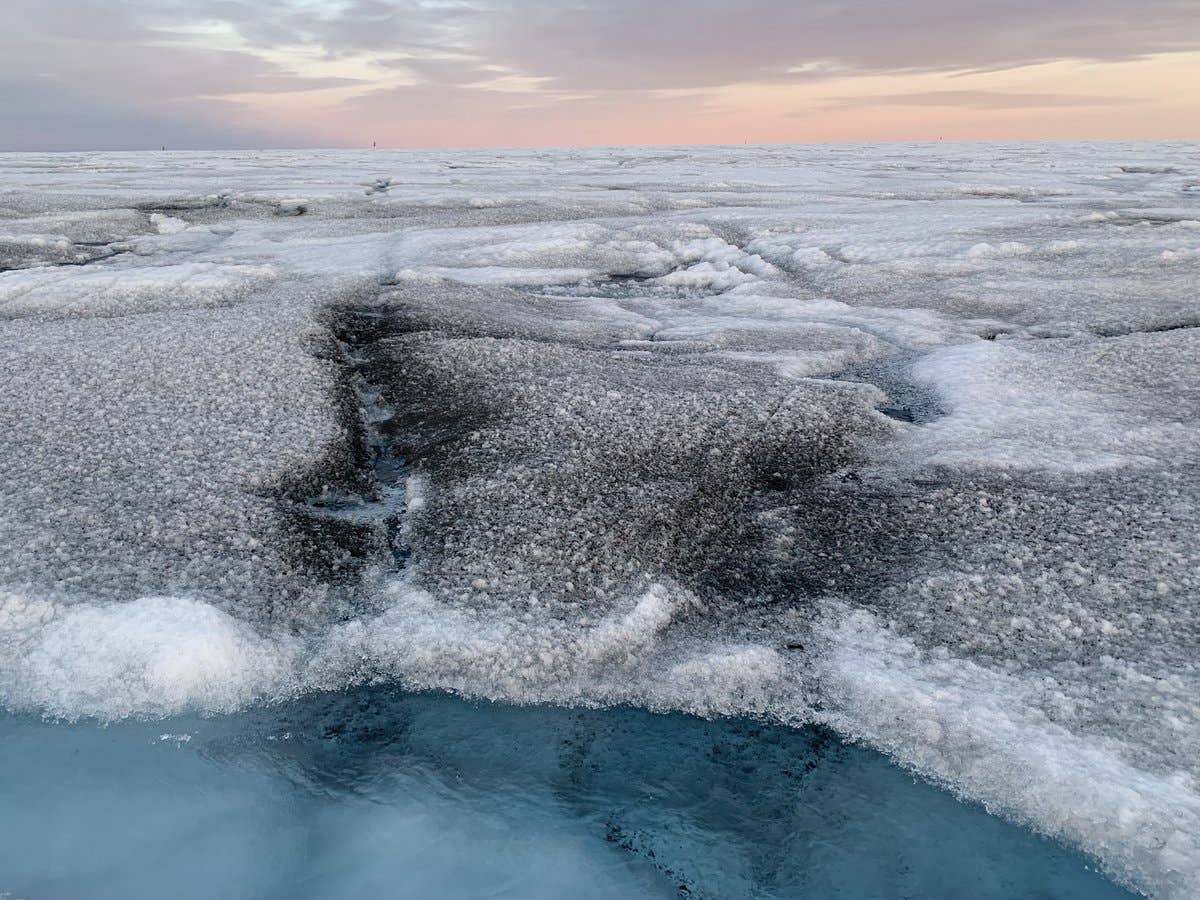Giant viruses discovered on Greenland ice sheet
While most viruses are tiny—between 20 and 200 nanometers, which is about a thousand times smaller than bacteria—giant viruses are different.

The algae blackens the ice. When that happens the ice reflects less sunlight and melts faster. Several areas in Greenland are covered with black algae. (CREDIT: Laura Perini)
As the Arctic winter gives way to the bright, endless days of spring, life in this frozen region stirs back to activity. Polar bears emerge from their hibernation, the arctic tern returns from its long southern migration, and musk oxen make their way northward. The landscape, once dormant under the cover of darkness and snow, becomes a hub of activity once more.
But it's not just the more visible forms of life that spring into action. Beneath your feet, on the very surface of the ice, lies another kind of awakening. Dormant algae begin to bloom, turning vast stretches of the once-white ice into a darker shade. This change, though subtle, has profound consequences.
As the ice darkens, its ability to reflect sunlight diminishes. This causes the ice to absorb more heat, accelerating the melting process and contributing to global warming—a cycle that's been difficult to break.
In a promising development, researchers have started exploring a potential solution to this problem: controlling the growth of these snow algae. Laura Perini, a postdoctoral researcher from the Department of Environmental Science at Aarhus University, and her team have discovered something intriguing living alongside the algae—giant viruses.
Perini and her colleagues suspect these viruses could naturally curb the spread of snow algae, thereby slowing the melting of the ice. “We don’t know a lot about the viruses, but I think they could be useful as a way of alleviating ice melting caused by algal blooms. How specific they are and how efficient it would be, we do not know yet. But by exploring them further, we hope to answer some of those questions,” she explains.
These viruses are no ordinary microbes. While most viruses are tiny—between 20 and 200 nanometers, which is about a thousand times smaller than bacteria—giant viruses are different. They can grow to an impressive 2.5 micrometers, making them larger than many bacteria. But it's not just their size that sets them apart.
Their genetic material is also much more complex. A typical bacteriophage (a virus that infects bacteria) has a genome of 100,000 to 200,000 letters, while a giant virus boasts around 2.5 million letters in its genome.
Related Stories
Giant viruses were first identified in the ocean back in 1981, where they were seen infecting green algae. Since then, they've been found in various environments, including soil and even within human beings. However, Perini's discovery marks the first time these viruses have been detected on surface ice and snow teeming with microalgae.
“We analyzed samples from dark ice, red snow, and melting holes (cryoconite). In both the dark ice and red snow, we found signatures of active giant viruses. And that is the first time they’ve been found on surface ice and snow containing a high abundance of pigmented microalgae,” Perini notes.
Not too long ago, this part of the world was thought to be barren, a lifeless expanse of ice. But today, we know better. The ice is alive with microorganisms, forming an intricate ecosystem. This ecosystem includes bacteria, filamentous fungi, yeasts, and protists—small, single-celled organisms that feed on the algae.
Among these are the giant viruses that Perini and her team discovered. “There’s a whole ecosystem surrounding the algae. Besides bacteria, filamentous fungi and yeasts, there are protists eating the algae, different species of fungi parasitizing them, and the giant viruses that we found, infecting them,” she explains.
Understanding the biological controls acting on these algal blooms means studying these lesser-known players in the ecosystem—the fungi, protists, and giant viruses. However, despite their size, you won’t be able to see these giant viruses with the naked eye, or even with a standard light microscope. In fact, Perini hasn’t seen them directly herself yet. Instead, the discovery was made by analyzing DNA from samples collected from the ice.
The process involved sifting through a massive amount of genetic data, searching for specific markers that matched those of known giant viruses. To confirm that these were not just remnants of long-dead viruses, the team also extracted all the mRNA from the samples.
When the DNA in a virus is activated, it transcribes into mRNA, which acts as a recipe for building the proteins the virus needs to survive. The presence of mRNA confirms that the viruses are not only present but also alive and active on the ice.
In giant viruses, this genetic material forms a central core of DNA. This DNA contains all the instructions needed to create proteins—the chemical compounds responsible for most of the virus's functions. Unlike normal viruses, which rely on strands of RNA waiting to be activated when they infect a host, giant viruses can transcribe their DNA into mRNA on their own. This ability sets them apart from their smaller counterparts and offers a key marker of their activity.
Despite these exciting discoveries, much about giant viruses remains unknown. Unlike most viruses, they have a large number of active genes, enabling them to repair, replicate, transcribe, and translate their DNA. But what exactly these genes do and how the viruses interact with their hosts are questions that still need answering.
“We can’t link exactly which hosts the giant viruses infect. Some of them may be infecting protists, while others attack the snow algae. We simply can’t be sure yet,” says Perini. However, she’s determined to uncover more, with additional research in progress.
“We keep studying the giant viruses to learn more about their interactions and what exactly is their role in the ecosystem. Later this year we’ll release another scientific study with more info on giant viruses infecting a cultivated microalgae thriving on the surface ice of the Greenland Ice Sheet,” she concludes.
As the Arctic ice continues to change, understanding the complex relationships between its many inhabitants, from the algae to the giant viruses, may offer insights into how to mitigate some of the impacts of climate change.
The discovery of these giant viruses on the ice is a reminder that even in the most remote and seemingly lifeless places on Earth, there are still mysteries waiting to be uncovered, with potential implications for the future of our planet.
Note: Materials provided above by The Brighter Side of News. Content may be edited for style and length.
Like these kind of feel good stories? Get The Brighter Side of News' newsletter.
Joshua Shavit
Science & Technology Writer | AI and Robotics Reporter
Joshua Shavit is a Los Angeles-based science and technology writer with a passion for exploring the breakthroughs shaping the future. As a contributor to The Brighter Side of News, he focuses on positive and transformative advancements in AI, technology, physics, engineering, robotics and space science. Joshua is currently working towards a Bachelor of Science in Business Administration at the University of California, Berkeley. He combines his academic background with a talent for storytelling, making complex scientific discoveries engaging and accessible. His work highlights the innovators behind the ideas, bringing readers closer to the people driving progress.



